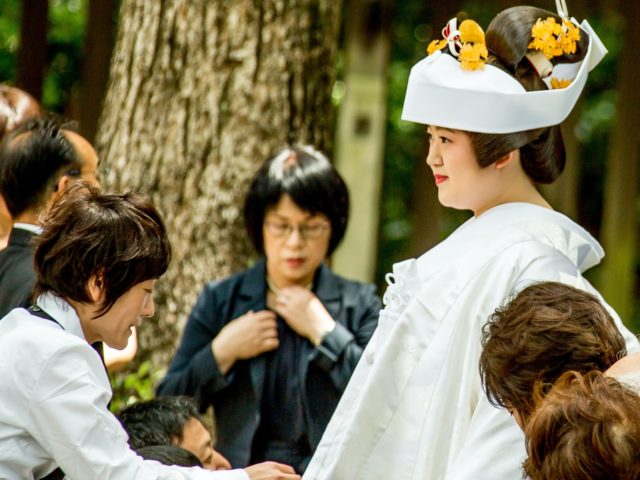Prime Minister Suga Yoshihide is planning to invest $19 million in the next fiscal year into “programs to help [Japan’s] residents find love,” an unnamed Cabinet official told the Japan Times this week, in an attempt to slow the nation’s rapidly declining birth rate.
While Japan has seen its population growth collapse in the past two decades – the product of unfavorable work environments for women that discourage pregnancies, an aging population that expects young women to care for them before starting their own families, and general disinterest in marriage among the nation’s youth – the Chinese coronavirus pandemic appears to be accelerating the decline. Japan, China, and South Korea are all struggling with maintaining their populations.
Among the “local government projects” Suga’s government will reportedly pursue is the use of artificial intelligence (A.I.) to help find interested single people a romantic partner, according to the Japanese newspaper Yomiuri Shimbun, which first broke the story.
The English-language Japan Times noted that the unnamed Cabinet official discussing the plan to help create more parents in the country would focus on artificial intelligence because “AI tech can match a wider and smarter range of potential suitors.”
About half of prefecture – Japan’s equivalent of state – governments already offer some form of matchmaking service or program to help promote childbirth for single residents, some of which are extremely expensive. In Urayasu, a suburb of Tokyo, the government launched a program in 2016 to subsidize the freezing of eggs for single women to give them more time to find a mate before their fertility naturally declines. At the time, the city announced an investment of $850,000 over three years to fund the preservation of human eggs; each individual procedure costs as much as $5,700. The city would pay as much as 80 percent of the cost per woman.
In the prefectures of Saga, Miyazaki, and Yamaguchi that year, governors targeted businesses that, in Japan, often force women to choose between having children or having a career. The pressure has resulted in so many women choosing the latter that Japan has one of the lowest birth rates in the world.
The governors of those states starred in a promotional video in 2016 called “The Governor is a Pregnant Woman,” in which they donned belly suits weighing 16 pounds, the average weight of a pregnant woman’s belly, while they went about their daily business. The video intended to urge men to empathize with pregnant women and help them remain vibrant parts of Japanese society, rather than forcing them back into their homes.
“I really didn’t understand. Now that I understand what my wife put up with for so many months, I’m full of gratitude,” Yamaguchi Governor Tsugumasa Muraoka said after conducting the experiment.
Multiple attempts have also surfaced within Japan’s political structure to attempt to preserve the nation’s population through mass immigration, but none have resulted in any significant change in Japan’s immigration policy. Japan remains one of the world’s most ethnically and racially homogenous societies and politicians attempting to pursue mass immigration policies often encounter significant resistance from those concerned that the nation’s cultural identity would fundamentally change without ensuring that immigrants assimilate into the culture.
Population experts have long insisted that a country needs to maintain a birth rate of 2.07 – meaning the average woman in the country must give birth to 2.07 children – to keep its population stable. Japan’s birth rate in 2019 was 1.36, the first time in nearly a decade that the rate fell under the already tenuous 1.40, according to the Japanese newspaper Asahi Shimbun. The figure represented the birth of over 50,000 fewer babies in the country between 2018 and 2019.
That number is expected to be even lower in 2020, a product in part of the Chinese coronavirus pandemic. Asahi noted in October that pregnancies documented nationwide between May and July declined 11.4 percent compared to the same time period in 2019. The number had already dropped 0.5 percent for the January-April window.
“The trend could be temporary if women are delaying their pregnancies simply because they are worried about becoming infected with the novel coronavirus,” Takumi Fujinami, a senior researcher at the Japan Research Institute, told Asahi. “What concerns me more is a sense of financial insecurity among young generations, a major factor behind the falling birthrate. If their economic conditions further worsen due to the fallout from the pandemic, that could lead to an even lower birthrate.”
The impact remains unclear of the Chinese coronavirus pandemic on the pressure in the workplace on women not to have children. Widespread reports for years have revealed that office bosses, including many women in positions of power, pressure women not to have children and, if pregnant, openly suggest they kill their unborn child. Many women reportedly feel pressure to publicly apologize to their entire office if they become pregnant. Japanese women have come to refer to the pressure, which some blame for not just abortions but miscarriages, as matahara.

COMMENTS
Please let us know if you're having issues with commenting.